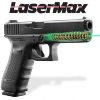I have a Kahr K9 Elite, PM9 and P380, all of which I upgraded to steel guide rods. In each case, I used Kahr's own optional steel guide rod. I figure if they sell it, it must be okay in their guns.
In the case of the P380, there was a small but noticeable reduction in felt recoil. It seemed to point a little easier also.
In the case of the PM9, I experienced similar results but to a lesser extent.
In the case of the K9 Elite, I also installed Kahr's extended and ported barrel. I use this gun as both a range toy, and as an introductory pistol for new shooters, as the extra weight and porting make it a soft shooter for newbies. I have never actually shot this firearm in its standard configuration, so I can make no observation there.
In the case of the P380, there was a small but noticeable reduction in felt recoil. It seemed to point a little easier also.
In the case of the PM9, I experienced similar results but to a lesser extent.
In the case of the K9 Elite, I also installed Kahr's extended and ported barrel. I use this gun as both a range toy, and as an introductory pistol for new shooters, as the extra weight and porting make it a soft shooter for newbies. I have never actually shot this firearm in its standard configuration, so I can make no observation there.



